Commercial-Scale Modification of NdFeB Magnets under Laser-Assisted Conditions
Abstract
:1. Introduction
2. Material and Methods
2.1. Materials
2.2. Coating Preparation
2.3. Surface Properties Study
2.4. Magnetic Flux Density Tests
3. Results and Discussion
3.1. Morphology Study
3.2. Spectroscopic Surface Analysis
4. Conclusions
Supplementary Materials
Author Contributions
Funding
Data Availability Statement
Conflicts of Interest
References
- Heim, J.W., II; Vander Wal, R.L. NdFeB Permanent Magnet Uses, Projected Growth Rates and Nd Plus Dy Demands across End-Use Sectors through 2050: A Review. Minerals 2023, 13, 1274. [Google Scholar] [CrossRef]
- Patcharawit, T.; Kritsarikan, W.; Yingnakorn, T.; Khumkoa, S. Comparative Study of Manufacturing NdFeB Magnet Wastes Recycling: Oxidative Roasting-Selective Leaching and Whole Leaching Routes. Recycling 2022, 7, 68. [Google Scholar] [CrossRef]
- Stein, R.T.; Kasper, A.C.; Veit, H.M. Recovery of Rare Earth Elements Present in Mobile Phone Magnets with the Use of Organic Acids. Minerals 2022, 12, 668. [Google Scholar] [CrossRef]
- Wu, Y.; Zhu, M.; Shen, P.; Fang, Y.; Sun, Q.; Zhang, L.; Wang, C.; Song, X.; Zheng, M.; Li, W. A design of sintered Nd-Fe-B magnet exhibiting superior corrosion resistance based on the metallurgical behavior of Ni and Cr. J. Mater. Res. Technol. 2023, 24, 6369–6377. [Google Scholar] [CrossRef]
- Hioki, K. Development of High-Performance Hot-Deformed Neodymium–Iron–Boron Magnets without Heavy Rare-Earth Elements. Materials 2023, 16, 6581. [Google Scholar] [CrossRef]
- Ormerod, J.; Karati, A.; Baghel, A.P.S.; Prodius, D.; Nlebedim, I.C. Sourcing, Refining and Recycling of Rare-Earth Magnets. Sustainability 2023, 15, 14901. [Google Scholar] [CrossRef]
- Cong, L.; Yu, L.; Zhou, Q.; Lu, Q.; Yue, M. Short-process recycling of Nd-Fe-B sintered magnet sludge wastes: Challenges and approaches. J. Rare Earths 2023, 41, 1467–1477. [Google Scholar] [CrossRef]
- Kovalenko, O.V.; Baulin, V.E.; Shulga, Y.M.; Baulin, D.V.; Gutsev, G.L.; Tsivadze, A.Y. Composite Resins Impregnated by Phosphorus Organic Extractants for Separation of Rare Earth Elements from Nitrate-Based Leachate of Permanent Magnets. Materials 2023, 16, 6614. [Google Scholar] [CrossRef] [PubMed]
- Dai, G.; Yin, W.; Tang, X.; Ju, J.; Wu, L.; Cui, Y.; Chen, R.; Yan, A. High-temperature magnetic performance and corrosion resistance of hot-deformed and sintered Nd-Fe-B magnets with similar room-temperature magnetic properties. J. Magn. Magn. Mater. 2023, 587, 171321. [Google Scholar] [CrossRef]
- Wu, J.; Aboulkhair, N.T.; Robertson, S.; Zhou, Z.; Bagot, P.A.; Moody, M.P.; Degano, M.; Ashcroft, I.; Hague, R.J. Amorphous-crystalline nanostructured Nd-Fe-B permanent magnets using laser powder bed fusion: Metallurgy and magnetic properties. Acta Mater. 2023, 259, 119239. [Google Scholar] [CrossRef]
- Yang, J.; Han, J.; Tian, H.; Zha, L.; Zhang, X.; Kim, C.S.; Liang, D.; Yang, W.; Liu, S.; Wang, C. Structural and Magnetic Properties of Nanocomposite Nd–Fe–B Prepared by Rapid Thermal Processing. Engineering 2020, 6, 132–140. [Google Scholar] [CrossRef]
- Liu, J.; Jiang, L.; Yang, Z.; Wang, L.; Gao, Z.; Shen, Q.; Fan, X.; Yang, H. Fabrication of Epoxy Composite Coatings with Micro-Nano Structure for Corrosion Resistance of Sintered NdFeB. Coatings 2023, 13, 1897. [Google Scholar] [CrossRef]
- Balaram, V. Rare earth elements: A review of applications, occurrence, exploration, analysis, recycling, and environmental impact. Geosci. Front. 2019, 10, 1285–1303. [Google Scholar] [CrossRef]
- Sprecher, B.; Xiao, Y.; Walton, A.; Speight, J.; Harris, R.; Kleijn, R.; Visser, G.; Kramer, G.J. Life Cycle Inventory of the Production of Rare Earths and the Subsequent Production of NdFeB Rare Earth Permanent Magnets. Environ. Sci. Technol. 2014, 48, 3951–3958. [Google Scholar] [CrossRef] [PubMed]
- Isotahdon, E.; Huttunen-Saarivirta, E.; Kuokkala, V.-T.; Paju, M.; Frisk, L. Corrosion protection provided by electrolytic nickel and tin coatings for Nd–Fe–B magnets. J. Alloys Compd. 2014, 585, 203–213. [Google Scholar] [CrossRef]
- Klemettinen, A.; Adamski, Z.; Leśniewicz, A.; Rycerz, L. Semicontinuous Process of Rare Earths Recovery from End-of-Life NdFeB Magnets on a Large Laboratory Scale. Minerals 2023, 13, 862. [Google Scholar] [CrossRef]
- Wu, Z.; Yu, Y.; Zhang, T.; Yu, R. Microstructure analysis of Ti-doped sintered Nd-Fe-B magnets. Acta Mater. 2023, 265, 119511. [Google Scholar] [CrossRef]
- Radwan-Pragłowska, N.; Węgiel, T.; Borkowski, D. Modeling of Axial Flux Permanent Magnet Generators. Energies 2020, 13, 5741. [Google Scholar] [CrossRef]
- Sypniewska, J.; Szkodo, M.; Majkowska-Marzec, B.; Mielewczyk-Gryń, A. Effect of hybrid modification by ceramic layer formation in MAO process and laser remelting on the structure of titanium bio-alloy Ti13Nb13Zr. Ceram. Int. 2023, 49, 16603–16614. [Google Scholar] [CrossRef]
- Pola, J. Thermal reactive modifications of polymer surfaces by infrared laser radiation. J. Anal. Appl. Pyrolysis 2023, 169, 105819. [Google Scholar] [CrossRef]
- Saran, R.; Ginjupalli, K.; Sajan, D.G.; Santhosh, C.; Unnikrishnan, V.K. LASER as a tool for surface modification of dental biomaterials: A review. Heliyon 2023, 9, e17457. [Google Scholar] [CrossRef]
- Samanta, A.; Wang, Q.; Shaw, S.K.; Ding, H. Roles of chemistry modification for laser textured metal alloys to achieve extreme surface wetting behaviors. Mater. Des. 2020, 192, 108744. [Google Scholar] [CrossRef]
- Zheng, J.X.; Tian, K.S.; Qi, J.Y.; Guo, M.R.; Liu, X.Q. Advances in fabrication of micro-optical components by femtosecond laser with etching technology. Opt. Laser Technol. 2023, 167, 109793. [Google Scholar] [CrossRef]
- Wu, H.; Wu, Y.; Yan, M.; Tu, B.; Li, Y. Microstructure and mechanical properties of surface coating prepared on grade 2 titanium by Ni-B composite electroplating and laser cladding. Opt. Laser Technol. 2023, 164, 109498. [Google Scholar] [CrossRef]
- Deng, W.; Wang, C.; Lu, H.; Meng, X.; Wang, Z.; Lv, J.; Luo, K.; Lu, J. Progressive developments, challenges and future trends in laser shock peening of metallic materials and alloys: A comprehensive review. Int. J. Mach. Tools Manuf. 2023, 191, 104061. [Google Scholar] [CrossRef]
- Zhou, L.; Ma, G.; Zhao, H.; Mou, H.; Xu, J.; Wang, W.; Xing, Z.; Li, Y.; Guo, W.; Wang, H. Research status and prospect of extreme high-speed laser cladding technology. Opt. Laser Technol. 2024, 168, 109800. [Google Scholar] [CrossRef]
- Zhu, L.; Xue, P.; Lan, Q.; Meng, G.; Ren, Y.; Yang, Z.; Xu, P.; Liu, Z. Recent research and development status of laser cladding: A review. Opt. Laser Technol. 2021, 138, 106915. [Google Scholar] [CrossRef]
- Wang, Y.; Zhu, M.; Sun, Q.; Xia, F.; Zuo, J.; Wu, Y.; Song, X.; Li, Z. High-quality TbF3 coating prepared by suspension plasma spraying technique for improving the grain boundary diffusion efficiency of sintered Nd-Fe-B magnets. Surf. Coat. Technol. 2023, 465, 129575. [Google Scholar] [CrossRef]
- Wei, Z.; Najafi, A.; Taheri, M.; Soleymani, F.; Didehvar, N.; Khalaj, G. The Effect of an Ultrasonic Field on the Microstructure and Tribological Behavior of ZrB2/ZrC+Ni60A/WC Composite Coating Applied by Laser Cladding. Coatings 2023, 13, 1928. [Google Scholar] [CrossRef]
- Schäfer, K.; Fim, R.G.T.; Maccari, F.; Braun, T.; Riegg, S.; Skokov, K.P.; Koch, D.; Bruder, E.; Radulov, I.; Ahrens, C.H.; et al. Laser powder bed fusion of anisotropic Nd-Fe-B bonded magnets utilizing an in-situ mechanical alignment approach. J. Magn. Magn. Mater. 2023, 583, 171064. [Google Scholar] [CrossRef]
- Pelevin, I.A.; Ozherelkov, D.Y.; Chernyshikhin, S.V.; Nalivaiko, A.Y.; Gromov, A.A.; Chzhan, V.B.; Terekhin, E.A.; Tereshina, I.S. Selective laser melting of Nd-Fe-B: Single track study. Mater. Lett. 2022, 315, 131947. [Google Scholar] [CrossRef]
- Nguyen Van, T.; Moraes, I.; Dempsey, N.M.; Champeaux, C.; Dumas-Bouchiat, F. Textured Nd-Fe-B hard magnetic thin films prepared by pulsed laser deposition with single alloy targets. J. Magn. Magn. Mater. 2021, 520, 167584. [Google Scholar] [CrossRef]
- Molian, R.; Molian, P. Pulsed laser deposition and annealing of Dy–Fe–B thin films on melt-spun Nd–Fe–B ribbons for improved magnetic performance. J. Magn. Magn. Mater. 2009, 321, 241–246. [Google Scholar] [CrossRef]

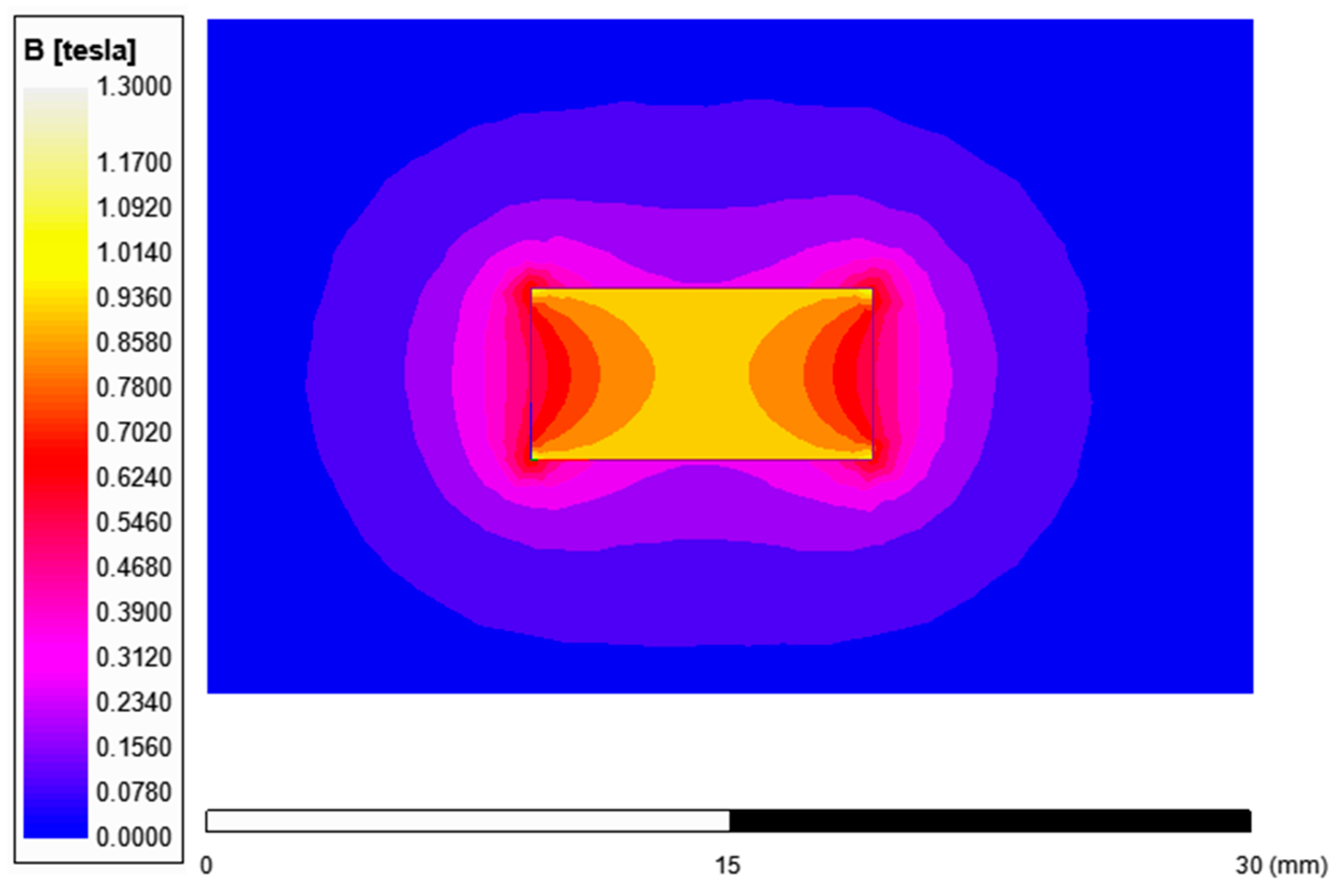
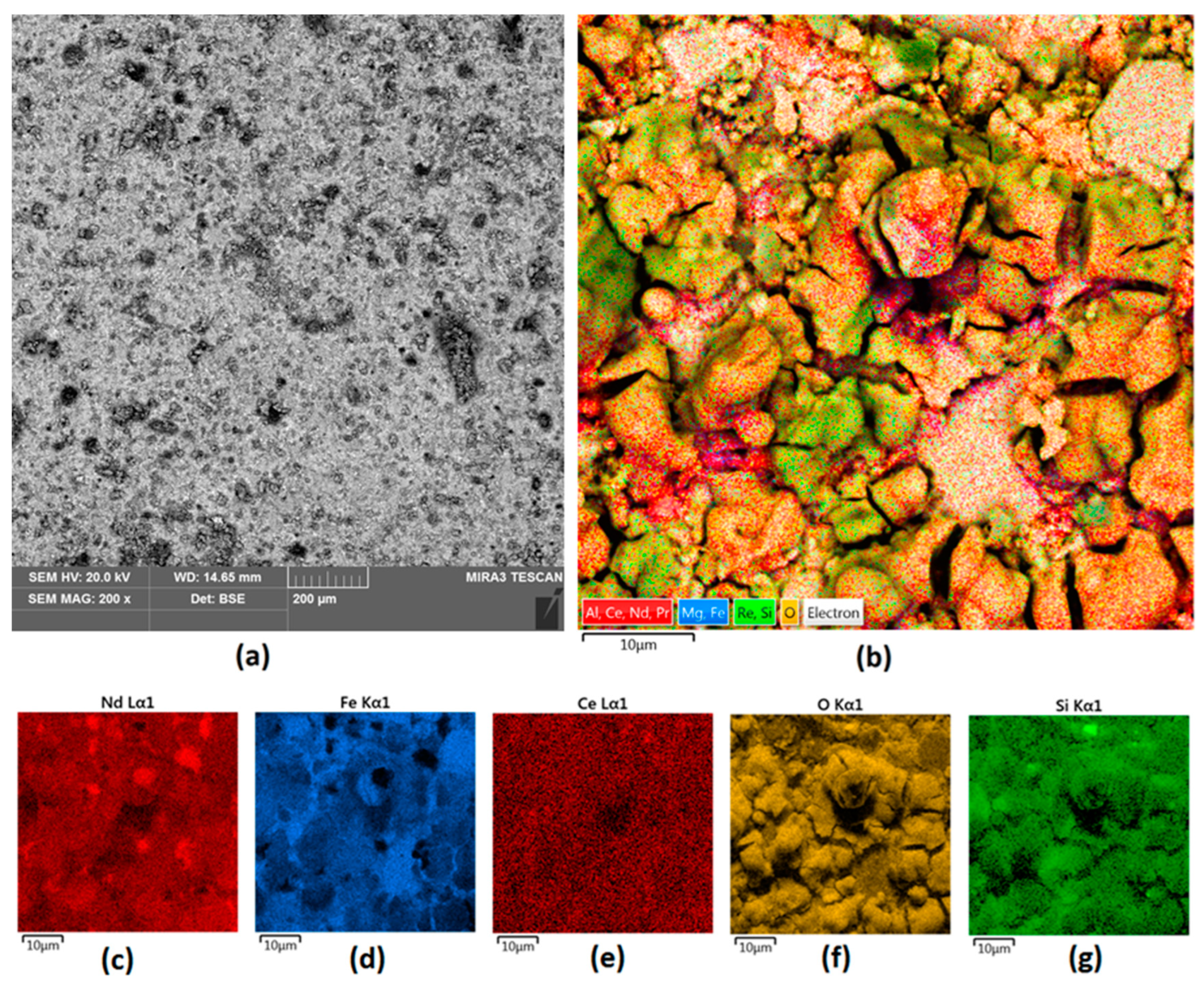
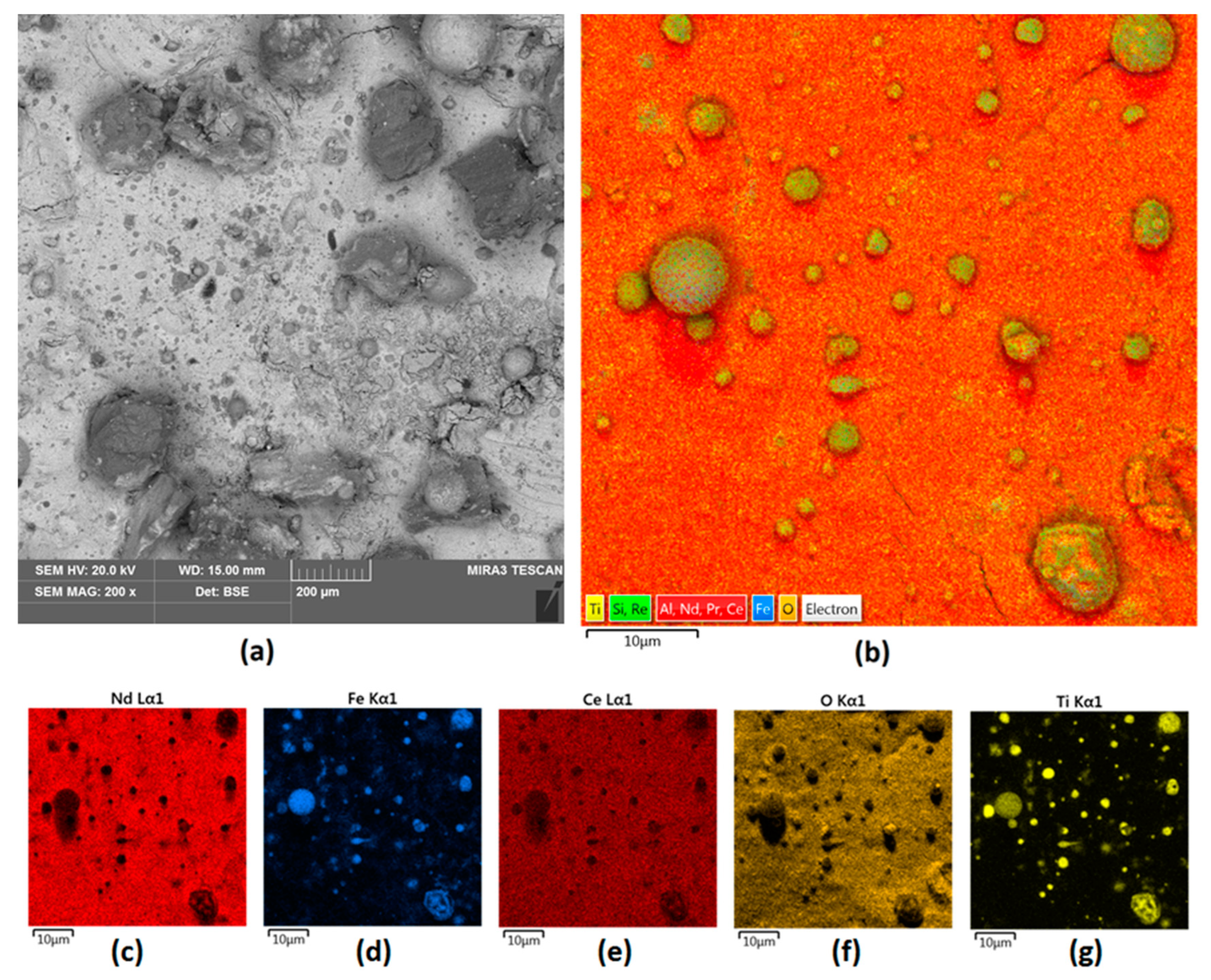
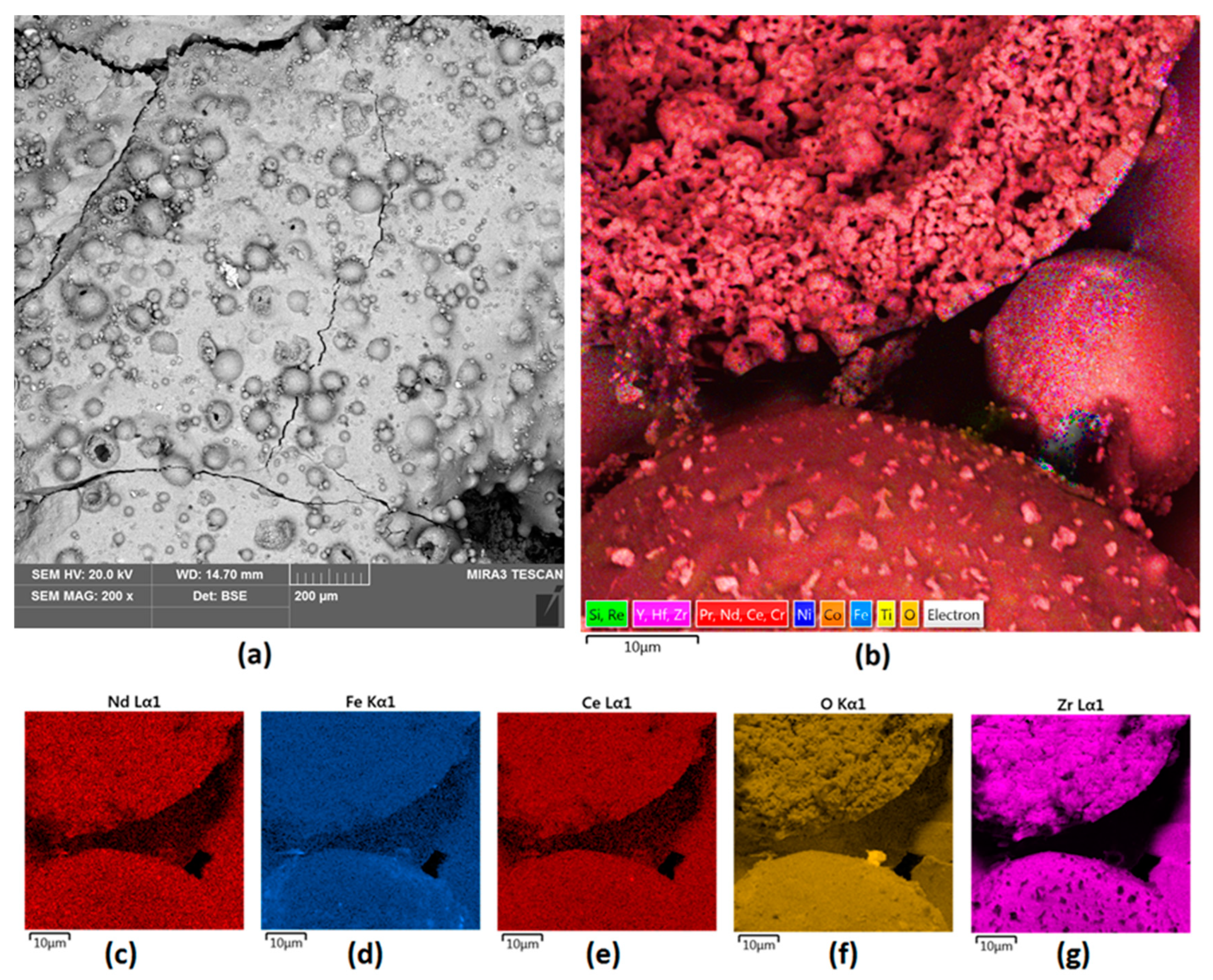
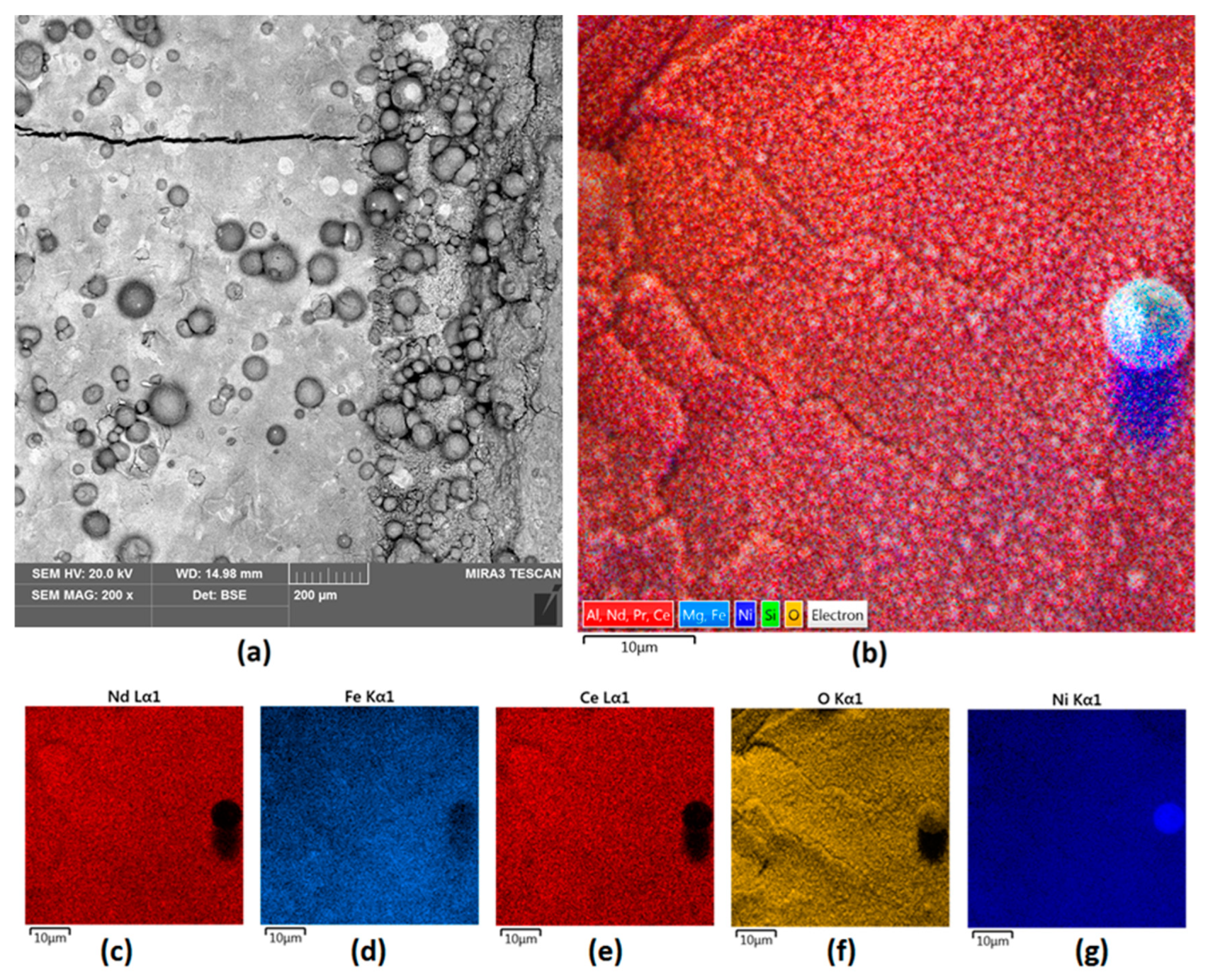
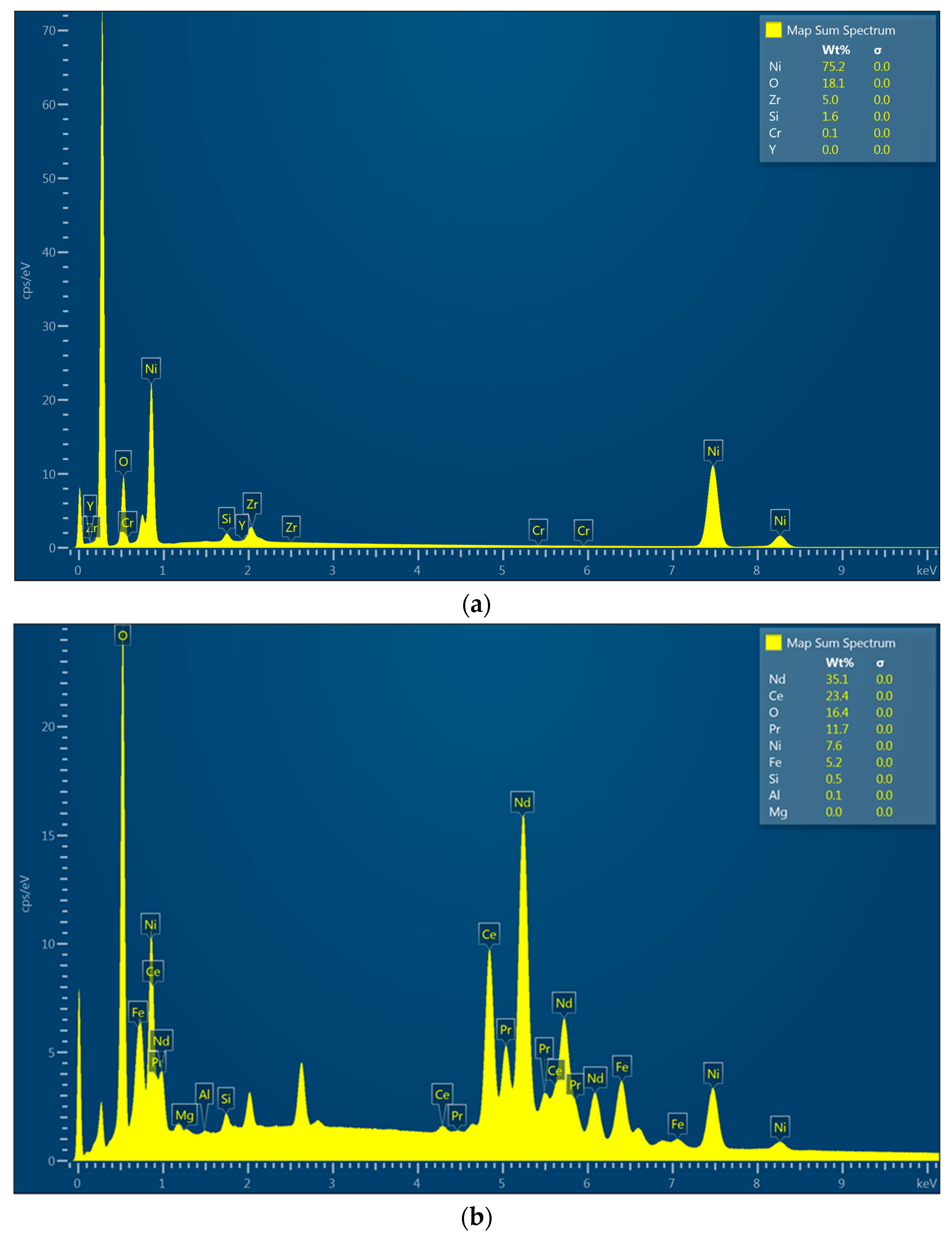

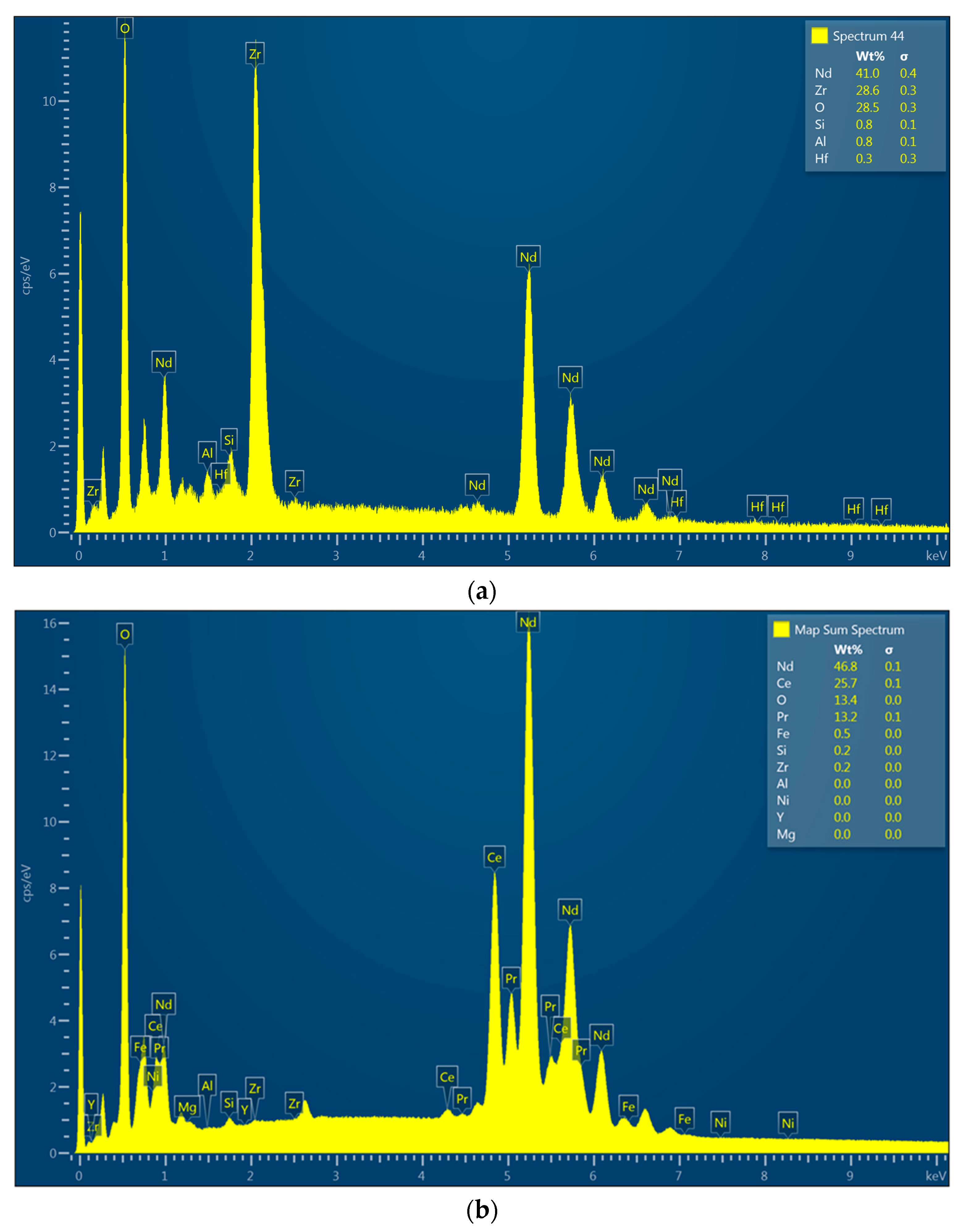
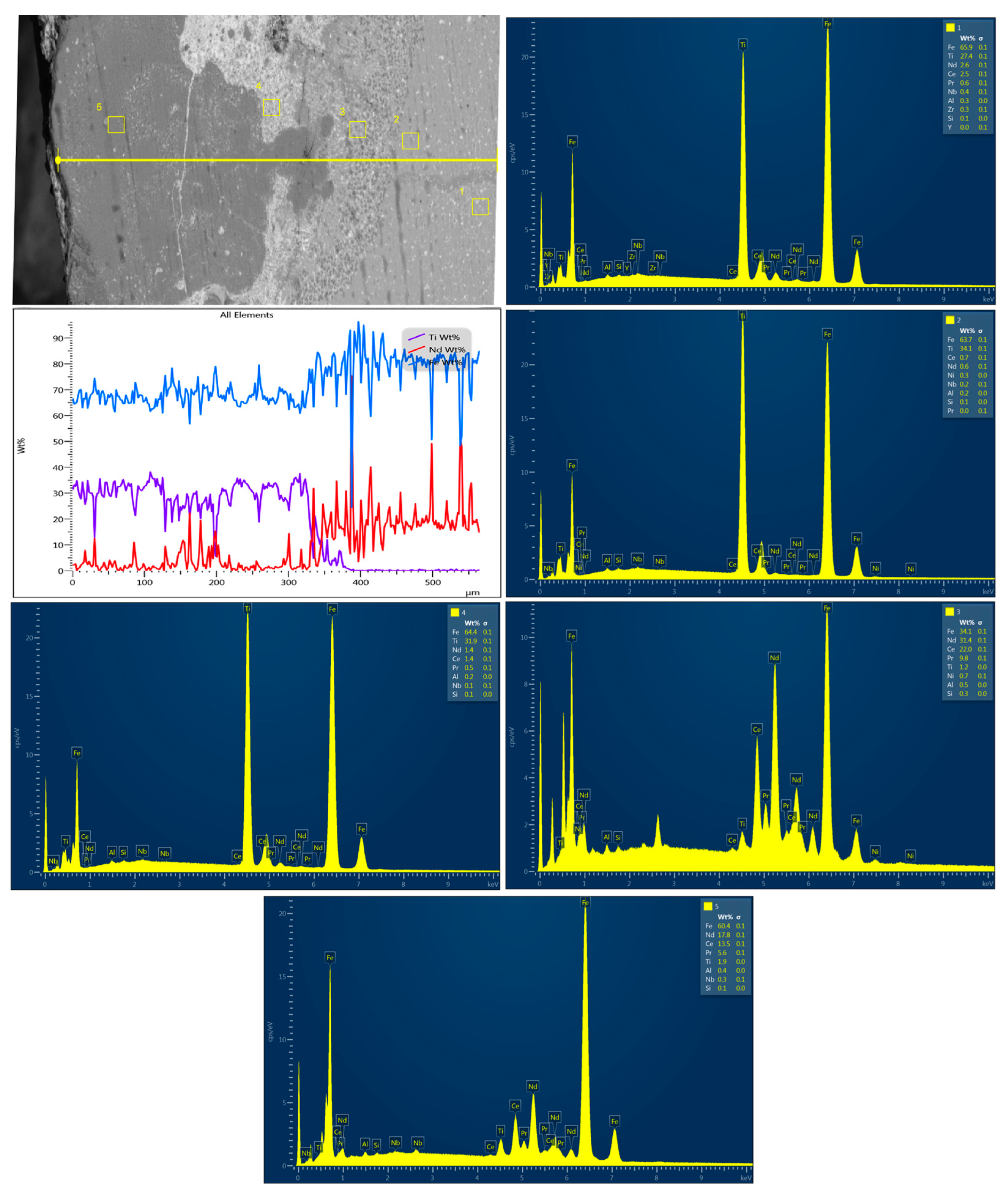

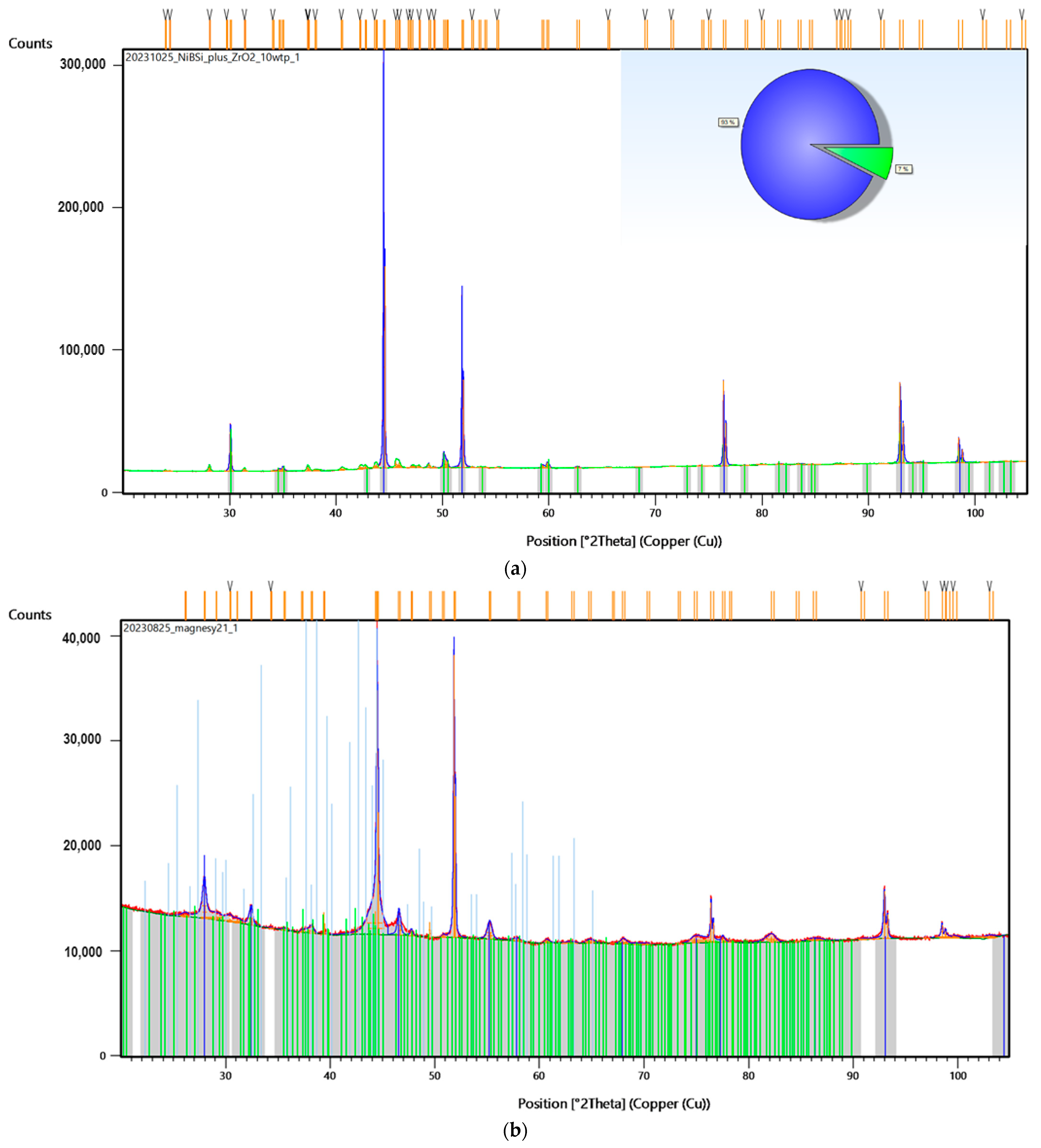
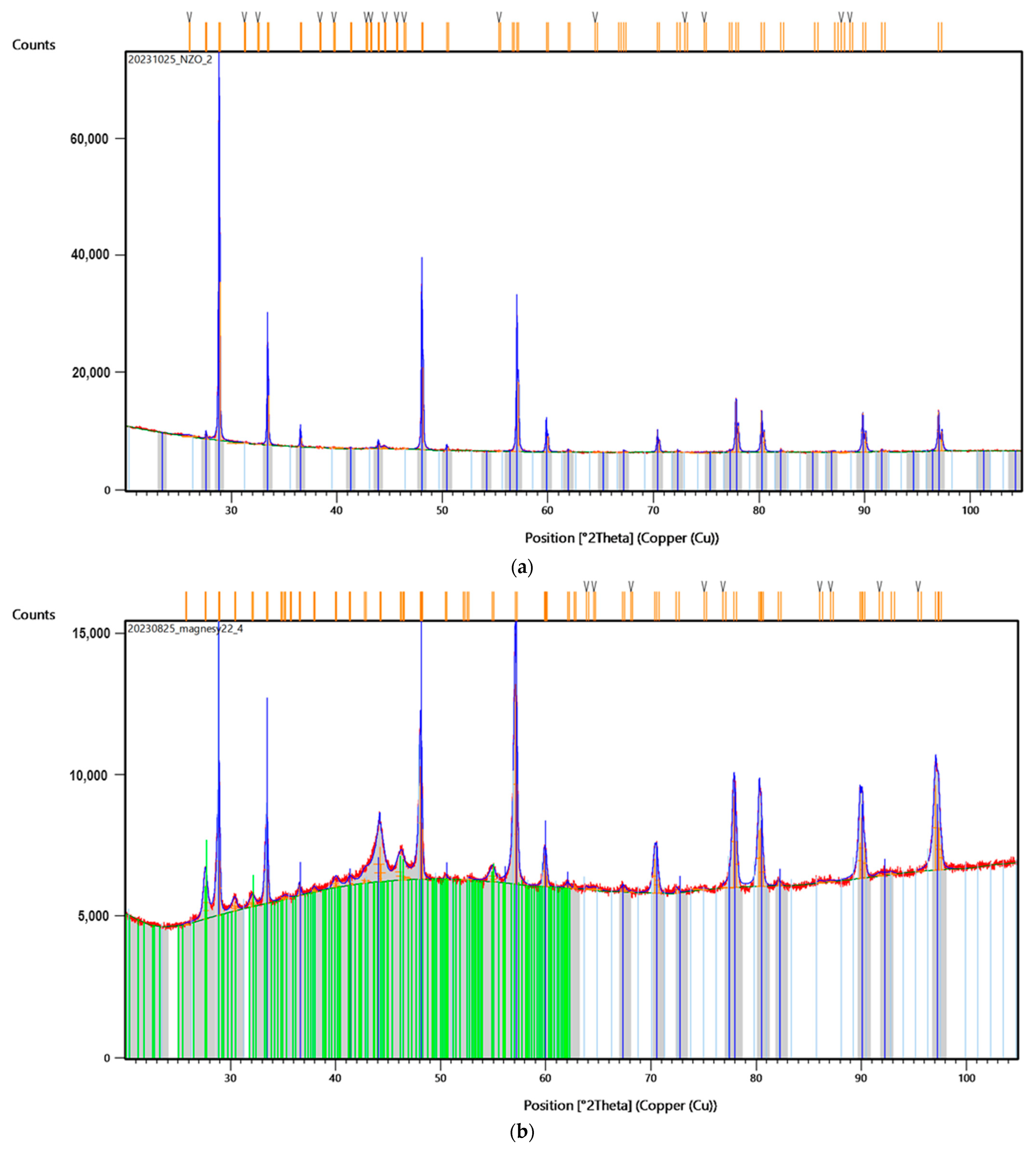


| Sample | Coating Thickness, µm |
|---|---|
| Ti/100 W | 380 |
| Ti/150 W | 313 |
| Ti/175 W | 297 |
| Ti/200 W | 288 |
| ZrO2/100 W | 342 |
| ZrO2/150 W | 335 |
| ZrO2/175 W | 326 |
| ZrO2/200 W | 312 |
| NiBSi/ZrO2/200 W | 1351 |
| Nd/ZrO2/200 W | 337 |
Disclaimer/Publisher’s Note: The statements, opinions and data contained in all publications are solely those of the individual author(s) and contributor(s) and not of MDPI and/or the editor(s). MDPI and/or the editor(s) disclaim responsibility for any injury to people or property resulting from any ideas, methods, instructions or products referred to in the content. |
© 2024 by the authors. Licensee MDPI, Basel, Switzerland. This article is an open access article distributed under the terms and conditions of the Creative Commons Attribution (CC BY) license (https://creativecommons.org/licenses/by/4.0/).
Share and Cite
Radwan-Pragłowska, N.; Radwan-Pragłowska, J.; Łysiak, K.; Galek, T.; Janus, Ł.; Bogdał, D. Commercial-Scale Modification of NdFeB Magnets under Laser-Assisted Conditions. Nanomaterials 2024, 14, 431. https://doi.org/10.3390/nano14050431
Radwan-Pragłowska N, Radwan-Pragłowska J, Łysiak K, Galek T, Janus Ł, Bogdał D. Commercial-Scale Modification of NdFeB Magnets under Laser-Assisted Conditions. Nanomaterials. 2024; 14(5):431. https://doi.org/10.3390/nano14050431
Chicago/Turabian StyleRadwan-Pragłowska, Natalia, Julia Radwan-Pragłowska, Karol Łysiak, Tomasz Galek, Łukasz Janus, and Dariusz Bogdał. 2024. "Commercial-Scale Modification of NdFeB Magnets under Laser-Assisted Conditions" Nanomaterials 14, no. 5: 431. https://doi.org/10.3390/nano14050431







